Have you ever experienced something that completely altered how you see the world? Something that challenged your beliefs and values and ultimately led to a significant personal transformation?
This is the essence of transformative learning — a process of deep reflection and critical thinking that can fundamentally change how we understand ourselves and the world around us. From confronting our biases and assumptions to embracing new perspectives and ways of being, transformative learning can be a great instrument for personal growth and social change.
In this article, our experts explore the fundamental principles of transformative learning and how they can help you become a more engaged, empathetic, and productive learner.
👩🏫 What Is Transformative Learning?
Transformative learning is an educational theory developed by Professor Jack Mezirow in the 1970s, which challenges personal beliefs and perspectives through reflection and communication. Mezirow believed that adults need to experience a “disorienting dilemma” — a situation that challenges personal assumptions and views — to undergo transformative learning.
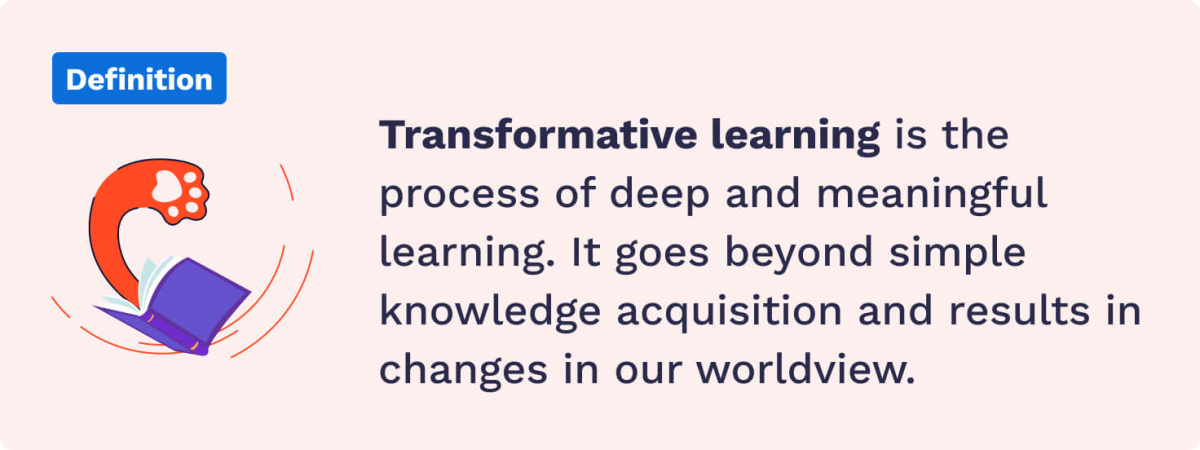
Nowadays, we understand transformative learning as a process of personal and cognitive growth. It involves critically reflecting on one’s assumptions, beliefs, and values and then reconstructing them based on new experiences. As a result, one can experience a shift in one’s worldview or perspective, resulting in a deeper understanding of oneself, others, and the world.
Transformative learning is often associated with adult education and can lead to personal empowerment, social change, and improved decision-making.
🧩 Transformative Learning Theory: Basic Components
Transformative learning is a powerful personal growth and development tool, and understanding its basic components is crucial for success. Whether you are an educator, student, or lifelong learner, understanding the essential elements we are about to discuss can help you reach your full potential.
Meaning Structures
The first important element of the transformative theory involves meaning structures or schemes. These are concepts, judgments, ideas, and emotions that shape our understanding of information.
Here are the types of meaning structures that influence how people interpret information:
- Sociolinguistic codes. They include cultural expectations, societal norms, and language use patterns.
- Psychological codes. These are individuals’ cognitive and emotional processes, including beliefs, attitudes, biases, and emotional responses.
- Epistemic codes. They involve reasoning, critical thinking, evidence evaluation, and knowledge organization.
Two Types of Learning
According to Mezirow, transformative theory centers around two primary types of learning:
- Instrumental learning emphasizes problem-solving and evaluating cause-and-effect relationships to solve task-oriented issues.
- Communicative learning focuses on how individuals express their emotions, needs, and desires through communication.
Both learning types play crucial roles in transformative theory, as learners need to be open to new perspectives that involve both logical and emotional considerations. By embracing instrumental and communicative learning approaches, learners gain a comprehensive toolkit for transformative learning.
💡 Key Principles of Transformative Learning
Transformative learning theory is based on three fundamental principles that explain the process of adult education. These are the centrality of experience, critical reflection, and rational discourse. Let’s dive into each of them!
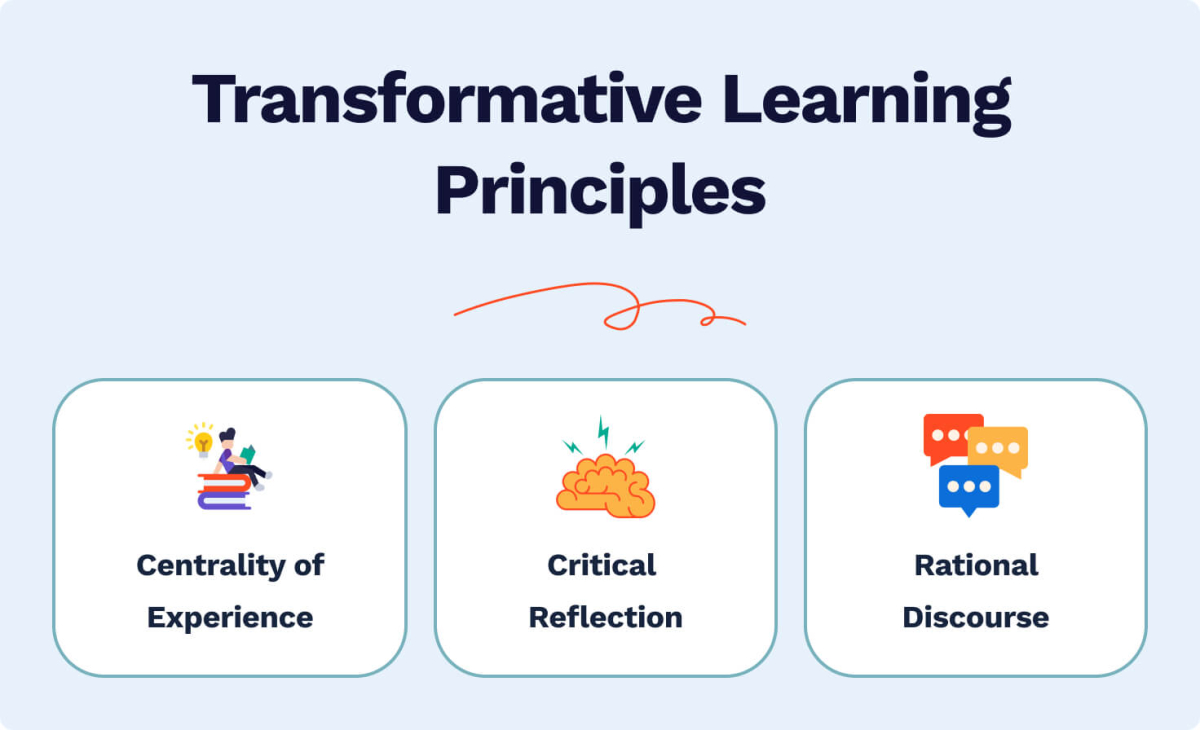
Centrality of Experience
The centrality of experience means that personal experiences play a crucial role in the learning process. According to this principle, meaningful learning and growth occur when individuals reflect on and critically examine their own experiences.
By actively engaging with and analyzing their experiences, individuals can challenge their beliefs, assumptions, and values, leading to transformative learning.
An example could be a student who learns about a historical event in class. However, it is only through participating in a museum tour or hearing firsthand stories from those who experienced it that they truly grasp the significance of that event.
Critical Reflection
The principle of critical reflection in transformative learning theory involves carefully examining our assumptions, beliefs, and experiences. It encourages us to question and challenge our perspectives, fostering personal growth and transformation.
Through critical reflection, individuals become aware of the societal and cultural influences that shape their thinking.
For example, someone may critically reflect on their childhood beliefs about gender roles and realize that these beliefs resulted from societal conditioning. This reflection can lead to a transformative shift in their understanding and acceptance of diverse gender identities and roles.
Rational Discourse
The principle of rational discourse emphasizes the importance of engaging in thoughtful and logical conversations to expand understanding and promote transformation. It involves creating an environment where learners can express their perspectives, listen to others, and engage in respectful, evidence-based dialogue.
Rational discourse enables people to challenge existing beliefs, explore new viewpoints, and collectively construct knowledge through reasoned exchange.
An example of rational discourse in action could be a group discussion on climate change. Participants exchange ideas, present scientific evidence, and critically analyze arguments, potentially transforming their perspectives.
❗ Why Is Transformative Learning Important?
Transformative learning is essential in education because it goes beyond simply transmitting knowledge and skills. It aims to shift individuals’ perspectives, beliefs, and values, leading to personal and academic growth.
Here are more reasons why transformative learning is important:
- It promotes diversity. Transformative learning encourages students to critically examine their assumptions and biases, allowing them to appreciate diverse perspectives, cultures, and backgrounds.
- It fosters students’ inquisitiveness. Transformative learning nurtures curiosity, encouraging students to ask questions, explore different ideas, and seek knowledge beyond the surface level.
- It improves critical thinking and problem-solving skills. By challenging existing knowledge and beliefs, transformative learning encourages students to analyze information, evaluate its validity, and apply logical reasoning to solve complex problems effectively.
- It helps students adapt to changes. In today’s fast-paced, dynamic world, adaptability is crucial. Transformative learning encourages the flexibility and open-mindedness necessary to embrace change.
👣 Mezirow’s Transformative Learning Theory: 10 Steps
If you are wondering how to start your transformative learning journey, Mezirow’s theory suggests ten steps. However, not everyone goes through every step, and the order may differ for each person. These steps help us understand the transformative learning process, but everyone’s experience is unique.
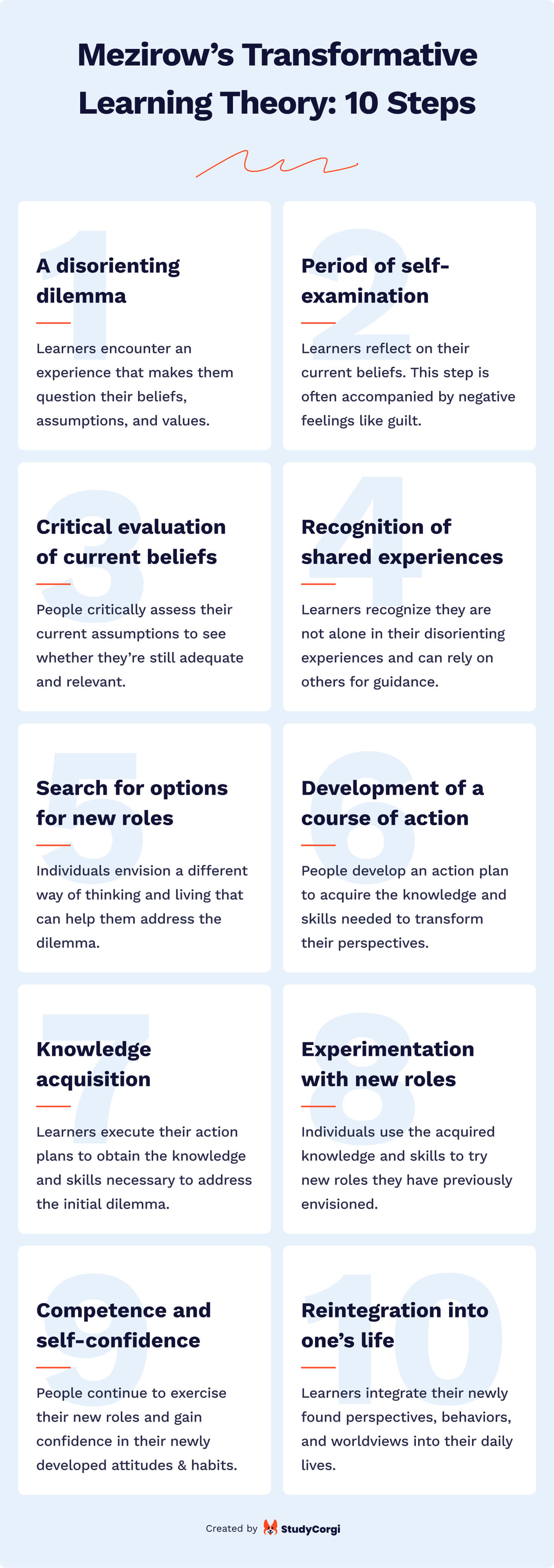
1. A Disorienting Dilemma
The first step of Mezirow’s transformative learning theory begins when an individual experiences a significant life event that challenges their current beliefs, values, and assumptions. This event is called a disorienting dilemma. It can be positive or negative and creates a sense of confusion or disorientation.
Let’s come up with an example:
Maria, a marketing executive, feels dissatisfied and unfulfilled in her current job. She encounters a situation where she sees a friend who has recently changed careers and seems much happier. This experience creates a disorienting dilemma for Maria, questioning her career path.
2. Self-Examination
The second step involves reflecting on one’s beliefs, values, and assumptions in light of the disorienting dilemma. This step requires individuals to examine their thoughts and feelings and question their assumptions critically.
Reflecting on her feelings, Maria engages in self-examination. She analyzes her strengths, interests, and values and what is missing or unsatisfying in her current job.
3. Critical Evaluation of Current Beliefs
In this step, individuals analyze their beliefs to determine whether they are accurate and valid. It involves questioning the source of their assumptions and considering alternative perspectives.
Maria critically evaluates her beliefs about success and fulfillment. She questions the idea that a high-paying job is the only path to happiness and considers whether aligning her passion with her career might be a better approach.
4. Recognition of Shared Experiences
The fourth step involves recognizing that other people have different perspectives and beliefs that may be equally valid. This step requires individuals to empathize with others and consider their points of view.
Maria talks to other professionals who undertook career changes and listens to their experiences. She recognizes that many successful individuals faced similar dilemmas and managed to find fulfillment in new roles.
5. Search for Options for New Roles and Actions
In this step, individuals explore perspectives and ideas that challenge their existing beliefs. This stage involves seeking out new information and engaging in dialogue with others who have different views.
Maria actively explores different career options that appeal to her. She researches industries, attends networking events, and engages with professionals from various fields to get insights into potential new roles.
6. Development of a Course of Action
The sixth step involves identifying specific actions necessary to achieve the desired transformative learning outcomes. It requires individuals to develop a plan for implementing new ideas and behaviors.
Based on her exploration, Maria develops a plan to transition into a career in sustainable development, combining her passion for the environment with her marketing skills. She charts out steps to acquire the necessary knowledge and skills.
7. Knowledge Acquisition
In this step, individuals acquire the knowledge and skills necessary to implement their action plan. For example, they can seek out education and training opportunities or develop new skills through practice.
Maria enrolls in online courses and attends workshops to acquire knowledge of sustainable development concepts, project management, and environmental policies.
8. Experimentation with New Roles
Experimentation with new roles involves putting new ideas or beliefs into practice and trying out different behaviors or actions related to the transformative learning experience.
Maria starts volunteering at a local environmental organization and takes on projects that allow her to apply her marketing skills in the context of sustainable initiatives. She experiments with different roles to gain insights and experience.
9. Development of Competence & Self-Confidence
Next, individuals continue practicing the new behaviors established during the previous step. As they do so, they build competence in their new roles and become confident that they are on the right path. This step requires individuals to take risks and be willing to make mistakes so that they can learn and grow.
Through her practical experiences, Maria develops competence in sustainable development practices and gains self-confidence in her ability to contribute meaningfully to the field.
10. Reintegration
Reintegration refers to incorporating the transformed beliefs, perspectives, and behaviors into one’s identity, creating a more coherent understanding of oneself and the world. This step requires individuals to reflect on their experiences and adjust their approach to achieve the desired goal.
Maria integrates her transformed beliefs, new knowledge, and skills into her identity. She successfully secures a marketing role focused on sustainable initiatives and feels a strong sense of fulfillment as she aligns her passion with her career.
⭐ Benefits of Transformative Learning
Transformative learning offers numerous benefits to those who engage in the process. Here are some of its key advantages.
🤔 How Can You Move Transformative Learning from Thought to Action?
We’ve already learned that transformative learning is a process that can help you develop critical thinking skills, challenge your assumptions, and gain new perspectives. If you are wondering where to start, check out our five practical ideas!
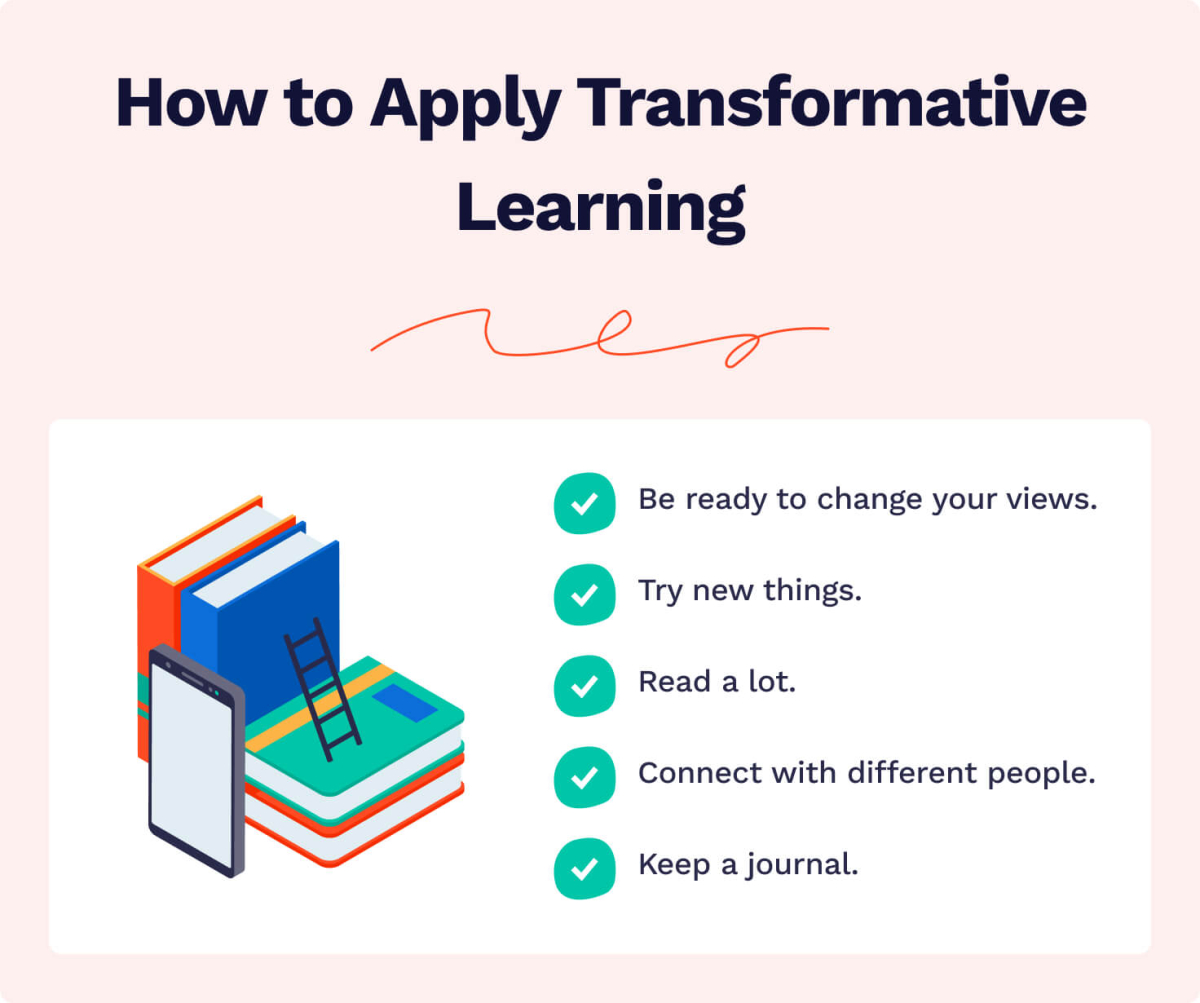
Be Open to Changing Your Perspective
To try transformative learning, you must be willing to challenge your current beliefs and assumptions. This can involve questioning your own biases and seeking out alternative viewpoints. For example, you could attend a lecture or workshop on a topic that challenges your current beliefs or read a book from a different cultural standpoint.
Being open to changing your perspective can help you better understand the world around you, develop problem-solving skills, and become more empathetic toward others.
Try New Things
Trying new things can help you broaden your horizons and gain new experiences. This can involve taking up a new hobby, traveling to a different place, or learning a new skill. By trying new activities, we break free from the constraints of routine and open ourselves up to possibilities and discoveries we may have never encountered otherwise.
This practice keeps life exciting and prevents boredom as you continually seek fresh challenges and learning opportunities.
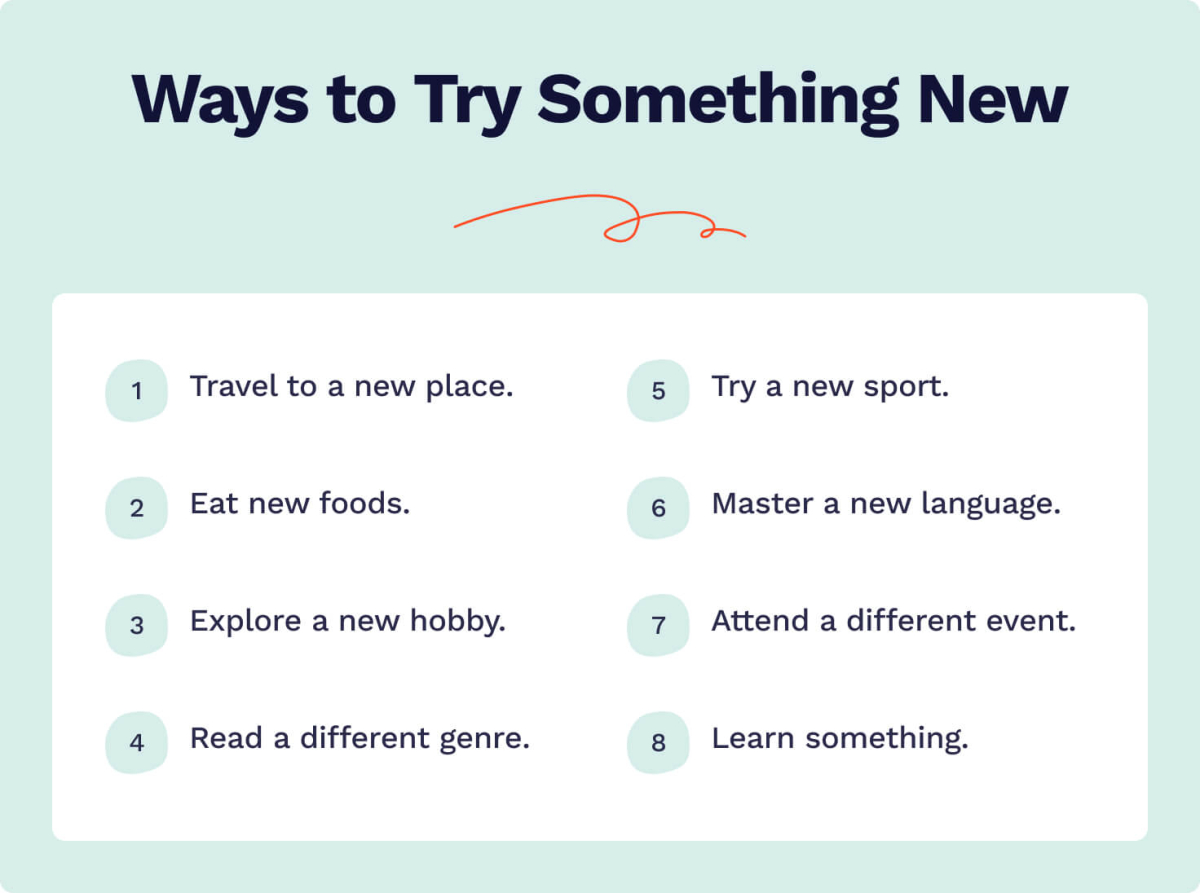
Read a Lot
Reading can be a powerful tool for transformative learning. Books offer a wealth of perspectives, experiences, and ideas that can challenge our existing beliefs, broaden our understanding, and foster personal growth.
Through reading, you can explore different cultures, engage with diverse narratives, and step into the shoes of characters who have faced unique challenges.
Connect with Different People
Meeting and communicating with people from different backgrounds can help you gain new insights. For example, you can join a college club, volunteer in your community, or attend networking events.
Connecting with different people also expands your social and professional networks, opening doors to new opportunities, collaborations, and friendships.
Keep a Journal
Keeping a journal can encourage you to reflect on your experiences and thoughts. You can gain clarity and insight into your beliefs and values by writing down your thoughts and feelings. Journaling can also help you reflect on your experiences as you try new things or meet new people.
Additionally, journaling promotes creativity and self-expression, empowering you to unleash your inner thoughts and ideas onto the page.
🎓 Transformative Learning Experience Examples
If you’re a student and want to immerse yourself in transformative learning, certain actions will help you. For example, educators suggest reading and watching more thought-provoking content, actively participating in team projects, conducting role-plays, and exchanging feedback with peers.
Below, you will find more activities to experience transformative learning.
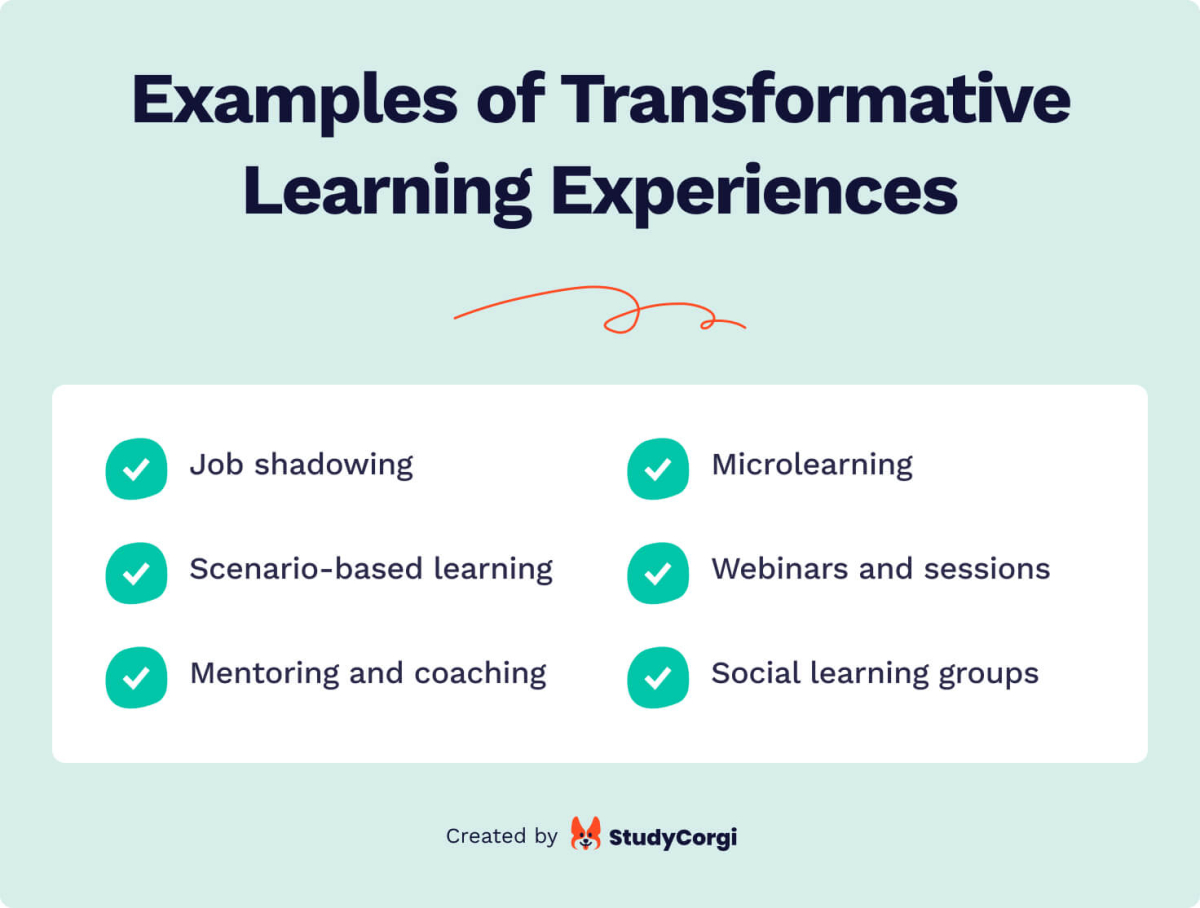
Job Shadowing
One activity that can aid in a transformative learning journey is job shadowing. It involves spending time with someone already working in the field or industry you are interested in. This activity allows you to observe and learn from someone with more experience and knowledge than you. It can help you realize what the job entails, what skills are required, and what challenges you may face. Job shadowing can also help you identify areas where you need to improve your skills and knowledge.
Scenario-Based Learning
Another activity that can become transformative is scenario-based learning. Scenario-based learning involves creating realistic scenarios that enable students to apply their knowledge and skills in a simulated environment. This activity can help you develop problem-solving, critical thinking, and decision-making skills. Scenario-based learning also allows you to understand better how to apply your knowledge and skills in real-life situations.
Mentoring and Coaching
Mentoring and coaching involve working closely with a more experienced person who provides guidance, feedback, and support. This experience can be transformative because it helps learners to identify their strengths and weaknesses, set goals, and develop strategies for improvement. By receiving personalized feedback and advice from a mentor, you can gain insights into your learning processes and achieve a sense of self-awareness that can help you become more effective.
Microlearning
Microlearning is another activity that is great for transformative learning. Instead of traditional lengthy training sessions, microlearning breaks down complex topics or assignments into bite-sized tasks.
To practice microlearning, you should set clear objectives, create a schedule, and carefully organize the content you’re about to learn. This activity can help you study at your own pace and on your own schedule, retain information better, and apply it more effectively.
Webinars and Sessions
Webinars and sessions play a crucial role in facilitating transformative learning. They provide opportunities for students to engage in interactive discussions, gain exposure to diverse viewpoints, and learn from experts or peers. These events foster critical thinking, self-reflection, and exploring different ideas.
By actively participating in webinars and sessions, you can enhance your cognitive abilities, challenge your assumptions, and develop greater empathy and understanding. Many interesting and free webinars are available on online learning platforms like Coursera and Udemy.
Social Learning Groups
The final transformative activity we recommend is social learning. Social learning groups connect students with similar interests and goals. These groups provide a collaborative environment where you can share ideas, ask questions, and learn from your peers.
To join a social learning group, check out clubs and organizations in your college. Alternatively, you can visit social media platforms like LinkedIn or Facebook and join online communities focused on specific topics.
🔶 Final Word
In a world where education often focuses on memorization rather than understanding, transformative learning stands as a beacon of hope. By challenging yourself to question your assumptions and explore new perspectives, you can become a critical thinker, a compassionate person, and a proactive agent of change.
Transformative learning has the power to inspire a lifelong desire for knowledge and personal development. So, dear reader, will you make space for transformative learning in your life? Share your thoughts below, and let’s continue the conversation.
